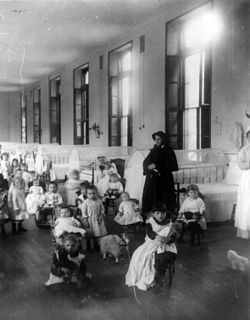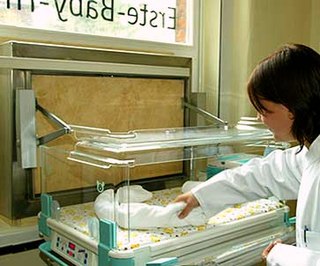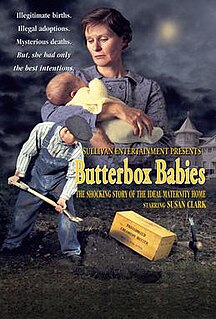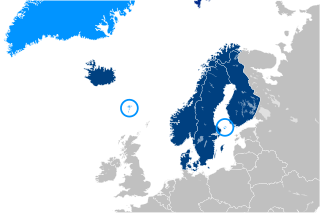
Adoption is a process whereby a person assumes the parenting of another, usually a child, from that person's biological or legal parent or parents. Legal adoptions permanently transfer all rights and responsibilities, along with filiation, from the biological parent or parents.
Child abandonment is the practice of relinquishing interests and claims over one's offspring in an illegal way with the intent of never resuming or reasserting guardianship. The phrase is typically used to describe the physical abandonment of a child, but it can also include severe cases of neglect and emotional abandonment, such as when parents fail to provide financial and emotional support for children over an extended period of time. An abandoned child is referred to as a foundling. Baby dumping refers to parents leaving a child younger than 12 months in a public or private place with the intent of terminating their care for the child. It is also known as rehoming when adoptive parents use illegal means, such as the internet, to find new homes for their children.

Lebensborn e.V. was an SS-initiated, state-supported, registered association in Nazi Germany with the goal of raising the birth rate of Aryan children of persons classified as 'racially pure' and 'healthy' based on Nazi racial hygiene and health ideology. Lebensborn provided welfare to its mostly unmarried mothers, encouraged anonymous births by unmarried women at their maternity homes, and mediated adoption of these children by likewise 'racially pure' and 'healthy' parents, particularly SS members and their families. The Cross of Honour of the German Mother was given to the women who bore the most Aryan children. Abortion was legalised by the Nazis for disabled and non-Germanic children, but strictly punished otherwise.
The international adoption of South Korean children started as a result of a large number of orphaned mixed children from the Korean War after 1953. Religious organizations in the United States, Australia, and many Western European nations slowly developed into the apparatus that sustained international adoption as a socially integrated system. This system, however, is essentially gone as of 2020. The number of children given for adoption is lower than in comparable OECD countries of a similar size, the majority of adoptees are adopted by South Korean families, and the number of international adoptees is at a historical low.

Parental leave, or family leave, is an employee benefit available in almost all countries. The term "parental leave" may include maternity, paternity, and adoption leave; or may be used distinctively from "maternity leave" and "paternity leave" to describe separate family leave available to either parent to care for small children. In some countries and jurisdictions, "family leave" also includes leave provided to care for ill family members. Often, the minimum benefits and eligibility requirements are stipulated by law.
Edna Browning Kahly Gladney was an early campaigner for children's rights and better living conditions for disadvantaged children.
The United States Children's Bureau is a federal agency organized under the United States Department of Health and Human Services' Administration for Children and Families. Today, the bureau's operations involve improving child abuse prevention, foster care, and adoption. Historically, its work was much broader, as shown by the 1912 act which created and funded it:
The said bureau shall investigate and report to [the Department of Commerce and Labor] upon all matters pertaining to the welfare of children and child life among all classes of our people, and shall especially investigate the questions of infant mortality, the birth-rate, orphanage, juvenile courts, desertion, dangerous occupations, accidents and diseases of children, employment, legislation affecting children in the several states and territories.

A baby hatch or baby box is a place where people can bring babies, usually newborn, and abandon them anonymously in a safe place to be found and cared for. This kind of arrangement was common in the Middle Ages and in the 18th and 19th centuries, when the device was known as a foundling wheel. Foundling wheels were taken out of use in the late 19th century, but a modern form, the baby hatch, began to be introduced again from 1952 and since 2000 has come into use in many countries, notably in Germany, where there are around 100 hatches, Czech Republic (76), Poland (67), and in Pakistan where there are more than 300 as of 2006.

Beulah George "Georgia" Tann was an American child trafficker who operated the Tennessee Children's Home Society, an adoption agency in Memphis, Tennessee. Tann used the unlicensed home as a front for her black market baby adoption scheme from the 1920s until a state investigation into numerous instances of adoption fraud being perpetrated by her closed the institution in 1950. Tann died of cancer before the investigation made its findings public. Tann's custom of placing children with influential members of society normalized adoption in America, and many of her adoption practices became standard practice.
Child protective services (CPS) is the name of a government agency in many states of the United States responsible for providing child protection, which includes responding to reports of child abuse or neglect. Some states use other names, often attempting to reflect more family-centered practices, such as department of children and family services (DCFS). CPS is also sometimes known by the name of department of social services, though these terms more often have a broader meaning.
Tennessee Children's Home Society was an orphanage that operated in the state of Tennessee during the first half of the twentieth century. It is most often associated with its Memphis branch operator, Georgia Tann, as an organization involved in the kidnapping of children and their illegal adoptions. Tann died in 1950 before the state of Tennessee could release its findings on her activities. A story reported by 60 Minutes in 1991 renewed interest in Tann's black market adoptions in collaboration with Shelby County Juvenile Court Judge Camille Kelley.
Family preservation was the movement to help keep children at home with their families rather than in foster homes or institutions. This movement was a reaction to the earlier policy of family breakup, which pulled children out of unfit homes. Extreme poverty alone was seen as a justified reason to remove children. This new movement began in the 1890s, and in the 1909 White House Conference on Children it was the top ranked issue. In order to keep families together, the family would be given enough money so that the mother would not have to work a full-time job. The families that were given this assistance were usually headed by widows.
The Baby Scoop Era was a period in anglosphere history starting after the end of World War II and ending in the early 1970s, characterized by an increased rate of pre-marital pregnancies over the preceding period, along with a higher rate of newborn adoption.

Butterbox Babies is a film by Sullivan Entertainment and adapted from the book Butterbox Babies by Bette L. Cahill. The film and book are based on the true story of the Ideal Maternity Home, a home for unwed pregnant mothers, during the Great Depression and Second World War. The home made millions from the illegal adoption of illegitimate babies during the 1930s and 1940s.

Social security in Finland, or welfare in Finland, is very comprehensive compared to other countries. In the late 1980s, Finland had one of the world's most advanced welfare systems, one that guaranteed decent living conditions for all Finns. Since then social security has been cut back, but still the system is one of the most comprehensive in the world. Created almost entirely during the first three decades after World War II, the social security system was an outgrowth of the traditional Nordic belief that the state was not inherently hostile to the well-being of its citizens, but could intervene benevolently on their behalf. According to some social historians, the basis of this belief was a relatively benign history that had allowed the gradual emergence of a free and independent peasantry in the Nordic countries and had curtailed the dominance of the nobility and the subsequent formation of a powerful right wing. Finland's history has been harsher than the histories of the other Nordic countries, but not harsh enough to bar the country from following their path of social development.
The Sixties Scoop was a period in which a series of policies were enacted in Canada that enabled child welfare authorities to take, or "scoop up," Indigenous children from their families and communities for placement in foster homes, from which they would be adopted by white families. Despite its name referencing the 1960s, the Sixties Scoop began in the mid-to-late 1950s and persisted into the 1980s.

Population planning in Singapore spans two distinct phases: first to slow and reverse the boom in births that started after World War II; and second, from the 1980s onwards, to encourage parents to have more children because birth numbers had fallen below replacement levels.
Child care in the United Kingdom is supported by a combination of rights at work, public sector provision and private companies. Child care is usually undertaken by the parents, and more often the mother who takes leave from employment. Early childhood education in a crèche or nursery is not freely available from the public sector, while fee-paying pre-schools are.
A maternity home, or maternity housing program, is a form of supportive housing provided to pregnant women. Maternity housing programs support a woman in need of a stable home environment to reach her goals in a variety of areas including education, employment, financial stability, prenatal care, and more. There are over 400 maternity homes in the United States ranging in size and criteria for admittance. Staffing model is a primary way that maternity homes differ. The three major staffing models are houseparents, live-in staff, and shift staff. Additionally, there are a limited number of maternity housing program who operate as a "shepherding" or "host" home. In the "host home" model, women are connected to screened households that offer to provide housing.
Birth mothers in South Korea refers to the group of biological mothers whose children were given up for adoption in South Korea's international adoption practice. The decades-long phenomenon of international adoption in South Korea began after the Korean War. In the years since the war, South Korea has become the largest and longest provider of children placed for international adoption, with 165,944 recorded Korean adoptees living in 14 countries, primarily in North America and Western Europe, as of 2014.








